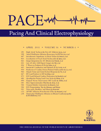Muscle Noise Effects on Atrial Evoked Response Sensing: Implications on Atrial Auto-Threshold and Auto-Capture Determination
Abstract
Background: Automatic pacing capture verification algorithms that are based on detection of local evoked response signals are susceptible to interference from myopotential noise. This is especially true in the atrium where the lower signal amplitude and signal-to-noise ratio make pacing capture verification more challenging. The aim of this study is to evaluate the impact of myopotential noise induced by various maneuvers on the atrial evoked response (AER) signal.
Methods: Data were collected from 18 patients (7 M/11 F, 77.6 ± 8.8 years), implanted with a dual chamber rate response (DDDR) pacemaker and acute and chronic right atrial leads and right ventricular leads, at three regular follow-up visits scheduled at 1, 3, and 6 months after pacemaker implantation or replacement procedures. During each study visit, manual atrial pacing threshold tests during unipolar pacing in the DDD mode were conducted with two evoked response sensing configurations (RARing→ Ind and RARing→ VTip) while patients performed six different maneuvers. Noise estimates were calculated for each maneuver.
Results: The greatest noise estimates in both sensing configurations were measured during the hand-pressing exercise (0.649 ± 0.342 mV in the RARing→ Ind vector, 0.309 ± 0.223 mV in the RARing→ VTip vector). No significant differences in overall noise estimates were observed between the follow-up visits. Of the beats that exhibited noise estimates greater than a sensing floor of 0.3 mV, up to 22% of cardiac beats had a signal-to-noise ratio less than 2 in the RARing→ Ind configuration.
Conclusions: Results indicate that myopotential noise generated by performing maneuvers has a demonstrable impact on AER sensing. Therefore, noise mitigation processes are necessary in atrial automatic pacing capture verification algorithms based on evoked response signals to identify and appropriately manage noise. (PACE 2011; 34:460–466)




